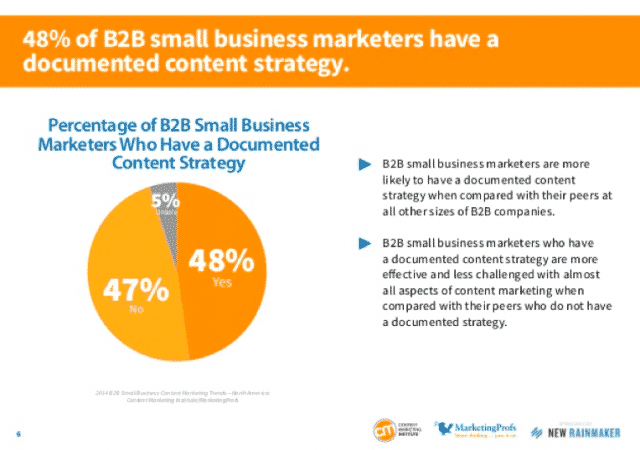Content is the single biggest driver of website traffic. Often regarded as the “lifeblood” of a website, traffic is a big component in judging a page’s success. More traffic creates more opportunities to convert and potentially spike revenue. Yet, the way we create content isn’t always thought out.
Content’s titanic impact on critical metrics and business dimensions (not just traffic, but also search rankings, customer experience, brand reputation, authority and others) has stirred up a feeding frenzy by companies across the board to push for more and more content.
Almost 95% of B2B companies produce content because an even greater percentage of their leads and customers expect it as a means to measure the trustworthiness of the organization, 87% of B2B marketers report issues creating content that truly engages their prospects and clients. Consumer-focused entities witness a similar trend.
The focus of this conversation is to look at some of the ways that a business can enhance their content and bring it to that next plateau. Specifically, content tactics that drive key metrics like engagement, visits and rankings, so you don’t have to be a member of that overcrowded contingency of businesses that find their content to be lackluster and unimpactful.
Have A Documented Plan Or Strategy
Without a doubt, the biggest mistake that companies make when drafting content is neglecting to have a documented plan or strategy behind their efforts. There’s an abundance of organizations that simply think of a topic, produce content regarding that subject, publish it and move on to the next project.
This “publish and pray” mentality is void of any real strategy, which means there’s very little room for measurement of ROI or understanding why things are working or not.

Having a content strategy allows a business to align the materials they produce with current business objectives and avoid the old fashioned publish and pray technique. It requires planning each new piece carefully to maximize the relevancy and value and thereby increase the potential ROI.
Formulating a great content strategy requires a business to analyze its customers and past content efforts to unearth insights into what the target audience wants from the content they ingest. As these desires and data change, it is easy to adjust the strategy to meet emerging attitudes.
Optimize Content With Search Keywords
Organic search is responsible for over half of an average site’s traffic and helps generate between 40% to 57% of revenue, depending on the industry. Capitalizing on this search traffic and potential revenue demands that content creators properly leverage keywords to be present in search results pages.
Again, analysis and planning are key to success. Smaller and newer websites are fighting an uphill battle against long-established, authoritative sites that have solidified a top ranking spot for popular, short-tail keywords. If you’re only focusing on incorporating the most immediate and obvious keywords, you won’t see big returns.
Instead, content that highlights lower competition keywords and long-tail keywords drive a greater number of new visits from organic search. This is especially crucial for new pages that need to build a foundation of SEO efforts to begin generating traffic and creating the trust and authority that Google and other search engines look for from top-ranking sites.
By finding easy-to-rank-for keywords with high traffic, you can establish a good basis of keywords to incorporate into content, which will help drive new visits and grow your rankings.
Balance Of Quality And Quantity
Creating engaging content that helps your pages climb the search rankings is a careful, tightrope walk between quantity and quality.
A HubSpot study found sites that published 16 or more posts a month saw 3.5 times higher traffic than those that posted 4 or fewer. In terms of length, 1,500 words is a good benchmark when it comes to written blogs. This equals about 7 minutes of read time, which isn’t too big of an expectation on audiences and produces a fair amount of dwell time on the page.
The challenge of frequently posting long-form content is obvious – it takes a lot of time and effort to create, especially for smaller businesses that have scarce resources. In order to meet the demands of a busy content schedule, some sites begin to sacrifice (often unknowingly) the quality of their posts.
When the quality of content goes down, so does its perceived value to audiences. And, when content’s value plummets, it causes a number of negative effects; visitors spend less time consuming content, which decreases dwell time and increases bounce rates. Ultimately, your rankings and customer experience suffer.
Content creators need to work within their means. Posting more is valuable, but only within reason. If you can’t maintain a consistent quality across your posts, it can do more harm than good.
That said, there are low-effort tactics that can help increase your monthly number of posts, such as:
- Drafting evergreen content that can be reposted again in the future
- Repurposing content in different formats; for instance, an old blog post can be repurposed as a podcast or video
- Encouraging guest posts from outside authors
- Focusing on content types that require less effort to create, but still offer ample value
Make Content Approachable
The closely related cousin of the discussion about quantity versus quality is approachability. Many visitors will quickly scan the page to see how accessible the content is and how much effort is required to extract the value of the piece.
If the content seems unapproachable, many visitors will click off this page. This creates a harmful bounce rate, thereby damaging your rankings, and results in little-to-no engagement. Thus, you want to make every effort to make all your content as accessible and user-friendly as possible.
There’s a number of components that make content more approachable and consumable by audiences:
Time & Length: As we touched on before, the length of your content is important to consider because it affects how much time out of the audience member’s day that you’re asking for. You don’t want to be too demanding of a visitor’s time. Whether it is a video, a blog post, a survey or another content type, if it’s too long, then many content consumers won’t want to engage at all.
Keeping content short and concise can be a challenge, but it creates a better experience for the customer because you’re imparting more value in a shorter amount of time. And, your audience’s time is incredibly precious. You should make the expectation of time immediately known to visitors. Many blogs do this with an “estimated read time” that is present at the top of the page.
Readability: You want to appear knowledgeable and an expert in your field. That’s how you build content that is valuable and engaging. After all, your audience wants to learn from you! But, in an attempt to establish credibility, content creators have a tendency to pack in sophisticated vocabulary, buzzwords and explain things in greater-than-necessary detail. This can actually be counterproductive.
Establishing your expertise and credibility through content is important, but the best avenue towards reaching that goal isn’t through flexing the depth of your vocabulary and literary prowess. It’s actually the opposite: disarming complex ideas and concepts in ways that are understandable, accessible and approachable by everyone. That’s the beauty of a blog post— it isn’t an academic paper, it’s a conversation.
There are reading level analysis tools, like Readable, that can help you craft content that is approachable by all audiences, though.
Structure: Again, content consumers have a knack for scanning the page to get an idea of how much effort is going to be required of them to access that page’s value. When they see a wall of text, it stirs up the nightmares and trauma born of pouring over thick, dense academic papers in college. Remember, you’re trying to create a conversation, not a lecture.
There’s a number of ways to structure content to make it visibly approachable, especially written blog posts. Whenever possible, you should use subheadings to break content down into more accessible sections. You can further improve the approachability of your content by incorporating bullet points, lists, graphs and images (pictures alone can help attract 94% more page visits!) that help streamline the information and concepts.
Conclusions
There is no perfect recipe for creating content that consistently engages your target audiences. You’ll have successful posts and unsuccessful posts.
That said, the key towards ensuring that you have more content wins than losses starts with a documented content strategy. When your efforts have a direction and a purpose, it is easier to identify the proper keywords to use and measure how many posts you’ll make, how long and how approachable each piece is and so on.
Then, it is a matter of adjusting your content strategy until you find the right, unique formula for your business’ audience to maximize engagement, drive new visits and boost search rankings.

